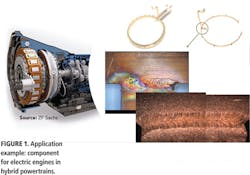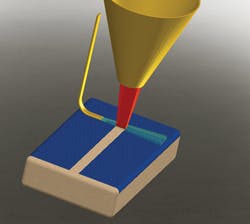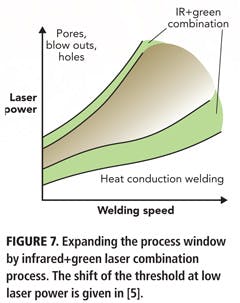Keeping historical buildings clean with lasers
How to remove the graffiti without damaging the underlying material
by J. Penide, F. Quintero, A. Riveiro, A. Sánchez-Castillo, R. Comesaña, J. del Val, F. Lusquiños and J. Pou.
It is never pleasant to wake up to horrible aerosol graffiti on your new stone fence. Of course, you would not be the first to encounter this problem. In fact, one of the first dismayed homeowners could have been the Altamira Caves (Spain) settlement chief when, returning from hunting 20,000 years ago, he found that the cave ceiling was daubed by some of his tribe (FIGURE 1, top). "What have you done to the ceiling?" he probably exclaimed when noticing the paintings made with mineral, animal, and vegetal pigments. Of course, there are no indications about the degree of success at that time of paintings like those at Altamira, or those paintings produced 32,000 years ago in Chauvet Cave, France, or those made 2000 years ago in Santa Barbara County, CA (FIGURE 1).
Today, this "cave art" is most often appreciated because it shows the ancient population's technical and mental abilities and the culture's ancient rituals or daily activity. Nevertheless, some critical voices ascribe those paintings to idle dwellers who had consumed natural hallucinogen/psychotropic substances: perhaps artistic rendering, but very close to our modern concept of "graffiti vandalism". Whatever the case, if this ancient population had desired to remove the paintings, it is clear that the required effort and time would have been beyond their capabilities.
Historical buildings
These days, the main problem is removing graffiti paint from historical buildings. Graffiti is more and more frequent on public buildings and even on monuments. Although graffiti is used by people to complain about politics, unemployment, religion, or whatever, that does not make graffiti licit. Restitution using constructive element substitution is not an option for this kind of construction, and the deterioration of the underlying surface constitutes a critical risk when the removal is addressed by conventional techniques. It must be realized that the surface's original features have to be preserved in congruence with the untreated part of the historical building. Graffiti causes a strong degradation of cultural heritage, endangers the esthetic appearance of the buildings, and worsens the historic value of the monuments.
The residents of Morelia, a city in the center of Mexico, know a lot about this issue. There, they live near an important historical center with buildings from the Hispanic colonial period. This historical center was even appointed a World Heritage Site by UNESCO in 1991 (see FIGURE 2). In spite of the site's importance, the quantity of graffiti keeps increasing even on the most common stone for building, locally designated as "cantera rosa de Morelia" or just cantera (quarry) or in English, pink Morelia quarry.
In 2008, the government of Morelia started a campaign to prevent and remove graffiti. It is currently investing hundreds of thousands of pesos per year on methods designed to remove graffiti. Because of a historical building's external aspects, the task is particularly delicate. The methods most employed are abrasive water jet cleaning and chemical removal. The first method is effective, but it can cause serious damage to the appearance of the stone. On the other hand, the chemicals used in the second method present health dangers.
Laser joint action
To help solve this problem, the Applied Physics Department at the University of Vigo (Spain) and the Faculty of Mechanical Engineering at the Michoacana University of San Nicolás de Hidalgo (Mexico) have carried out a joint action using lasers. Researchers working together in the laboratories of laser materials processing at the University of Vigo demonstrated a practical method to remove graffiti from pink Morelia quarry by laser. The laser beam has a very important advantage: it can be very accurately focused on the surface of the stone; its irradiance (i.e., power density) can be adequately tuned, and, because of its high precision, it is possible to remove the graffiti without affecting the stone. Particularly, we have chosen a high power diode laser (HPDL) because of its advantages.
First of all, the HPDL is compact and robust, which leads to the key advantage: portability. Therefore, it is possible to take the laser device to the street or building and remove graffiti in situ. Second, but also important, this kind of laser has a very long half-life and wall-plug efficiency exceeding 40%, one of the highest achieved in industrial laser sources. All experiments were carried out with a Dilas direct diode laser whose nominal maximum output power is 1500 W working at a wavelength of 940 nm. A focusing lens with focal length of 85 mm was used; the laser beam was focused on the surface of the stone, obtaining a rectangular spot of 5.1 x 2.2 mm2.
The process is based on focusing a laser beam on the surface of the stone so it removes the graffiti (see FIGURE 3) without affecting the stone. As we know, with a laser beam, only a small surface area is heated with an accuracy that is impossible to achieve by any other cleaning method. Moreover, by choosing a laser device with a suitable wavelength, we can also make the graffiti absorb most of the radiation so the underlying stone does not suffer any damage.
Despite the favorable properties of the HPDL, if we did not properly set it, we could fail by either not removing the graffiti or damaging the stone. Since the removal of graffiti is produced by a combination of evaporation and combustion, we undertook a comprehensive study to find the optimal parameters and conditions of the process to remove graffiti and return the stone to its original appearance. As shown in FIGURE 4, three different emission modes were tested: a single pass with modulated emission, a single pass with continuous wave emission, and two passes with continuous wave radiation.
After trying several configurations of assist gas, a processing head combining two nozzles to inject air at low pressure (5 bar) was selected. The first nozzle was coaxial with the laser beam, and the second one was perpendicular to it and also perpendicular to the movement direction.
Among the three methods tested, the two-pass one gave the best results. As the first two laser regimes failed, a different solution was required. Until then, experiments showed that lower levels of irradiance were insufficient to remove the paint but, instead, they were high enough to carbonize the paint, leading to a black residue. That color strongly absorbed the infrared radiation emitted by the HPDL so the laser beam could efficiently remove it from the stone. Then, the solution was clear: pass the laser beam twice over the painted stone. With lower values of irradiance than before, the first pass carbonized the paint and the second pass removed the remaining black residue so the stone was cleaned without producing side effects (see FIGURE 5). The optimal processing parameters of the laser device were 800 W/mm2 and 10 mm/s of sample speed.
Moreover, the laser treatment did not remove the original surface of the stone because of the controlled low irradiance level. Indeed, with the treatment of two laser passes, the stone preserved its characteristic pinkish color as well as its original surface roughness because the damage threshold was not reached.
The cross-section images of the laser-treated samples presented in FIGURE 6 demonstrate that the two-pass cleaning treatment produced a negligible heat affected zone. There is no cracking in the stone as a consequence of thermal damage. This yields an interesting result: the level of exposure is not as important as the irradiance. In fact, by setting a lower level of irradiance, even though the exposure is increased (by a multi-pass cleaning), the side effects in the surface of the stone are decreased. This result is supported by the fact that in the modulated wave treatment, we needed to use a higher level of irradiance to remove the graffiti than in the single-pass treatment and this, in turn, used a higher level of irradiance than in the two-pass treatment. As a consequence, the modulated wave provided poorer results than the single-pass treatment and, for the same reason: the two-pass treatment provided better results than the single-pass treatment. Therefore, the two-pass method was revealed to be more efficient thanks to its two-step process: the first low irradiance pass led to combustion-carbonization of the paint, and the second pass removed it.
Summary
In summary, the feasibility of a laser-based cleaning method to remove graffiti from pink Morelia quarry without damaging it has been demonstrated. It seems to be an interesting method since it is still very difficult to remove graffiti without producing side effects in the stone. Moreover, the advantages of HPDL such as its small size, its long duty life, and its high efficiency make it portable for graffiti removal in the street. We want to see Morelia free of this kind of vandalism, and in our opinion this method is a good way to achieve it. However, please do not try laser cleaning on the Altamira Caves. After thousands of years, we are used to graffiti there and admire it. ✺
J. Penide, F. Quintero, A. Riveiro, R. Comesaña, J. del Val, F. Lusquiños and J. Pou([email protected]) are all with the Universidade de Vigo, Vigo, Spain. A. Sánchez-Castillo is with the Universidad Michoacana de San Nicolás de Hidalgo, Morelia, Mexico.
More Industrial Laser Solutions Current Issue Articles
More Industrial Laser Solutions Archives Issue Articles





